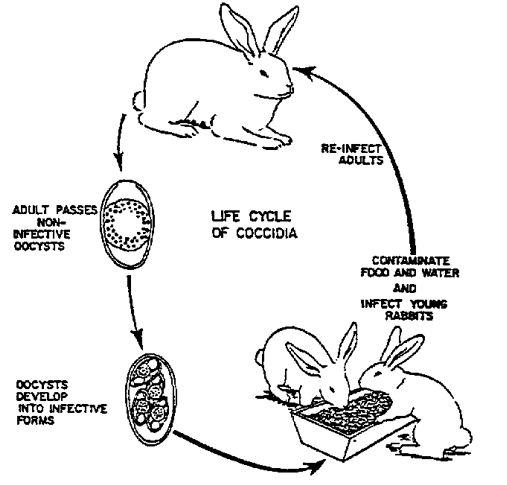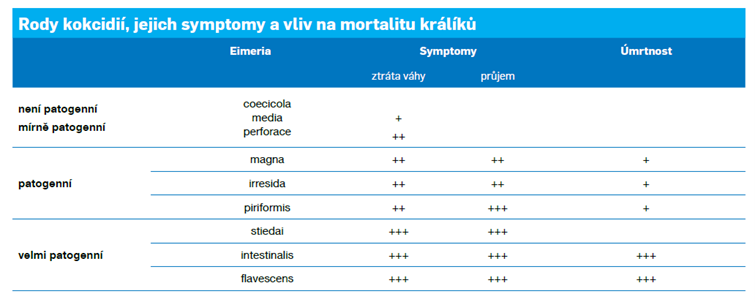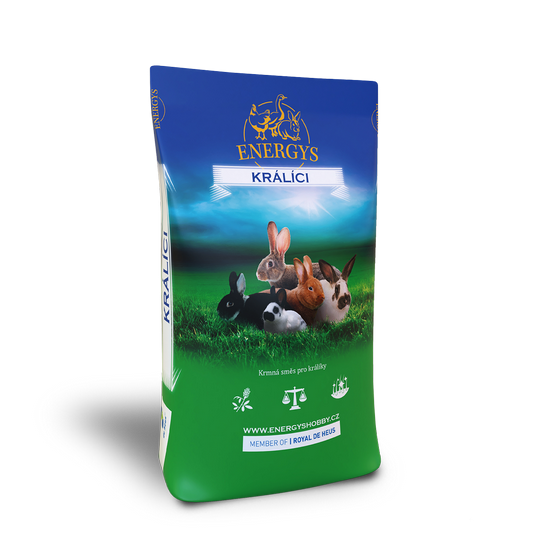Rabbits
Poultry
Laying hens
Quails
Guinea pigs
Pigs
Ostriches
Sheep and goats
Pigeons
Pheasants
Forest animals
Rabbit Coccidiosis
One of the most common and widespread parasitic diseases of rabbits worldwide is coccidiosis, which is encountered by most breeders in their lifetime and often has high negative economic impacts. It is most commonly found in intensive farms but can also occur in very well cared for rabbits or in wild rabbits.
Coccidiosis in rabbits is caused by intestinal or liver parasites, coccidia of the genus eimeria. Up to 25 species of eimeria coccidia have been observed in rabbits. Young animals, especially weaned rabbits, are primarily susceptible to coccidiosis caused by intestinal eimeria species. Liver coccidiosis usually affects rabbits of all ages. Adult rabbits most often act as carriers and are the source of infection.

Rabbit coccidiosis coccidia infect the lining of the intestine or liver. The parasite multiplies extensively in these sites and then leaves the body in faeces. The faeces then contaminate the water or feed. A rabbit becomes infected with sporulated oocysts* if it directly ingests food and water contaminated with faeces or whole faeces from another infected rabbit. Environmental hygiene is therefore very important and feeders with water containers should be designed to keep contamination to a minimum.
Clinical signs and severity of disease vary according to the species of coccidia, but also the amount of infective oocysts ingested, the immune status and nutritional status of the rabbit. In intestinal coccidia, the most common symptoms are weight loss, impaired growth parameters, hunching (a sign of pain), poor coat quality, pale mucous membranes, and decreased appetite. In case of intestinal coccidiosis, diarrhoea, dehydration and mucus with blood can be observed in the faeces. Death may occur. In young rabbits, growth retardation occurs mainly due to negative side effects on the kidneys and liver. Coccidia reduce carcass weight by more than 23 %.

The prevention of disease is proper hygiene, which has already been mentioned, checking the droppings every 3-4 months (take from the most at-risk category of rabbits at around 50 days of age) and the use of coccidiostats. Coccidiostats are often contained in ready-made compound feeds (rabbit classic forte) or can be supplied as a supplement to feeds that do not contain coccidiostats.
If an outbreak of coccidiosis occurs, fattening rabbits can be treated with a solution of sodium sulfadimidine in water (1 gram per litre of water over 3 days, repeated after 7 days). Another treatment against coccidiosis is to treat the water with baycox at 1 ml per litre of water (2 times 24 hours baycox, 2 days clean water, 2 times 24 hours baycox) or esb 3 (also 1 gram per litre of water over 3 days, repeat after 7 days). Consult your veterinarian for appropriate treatment.
Coccidia generally develop resistance to the drugs used very quickly.
Note: do not administer baycox to breeding females due to embryonic mortality. In a group system, baycox can be used from day 25 after birth. At this age, there is no longer any risk to the embryos.
And do you know the recipe for a drink to prevent coccidiosis? If not, here we present you!
Vinegar drink for the whole breed
You need:
1 liter of vinegar
1 large onion
2 cloves of garlic
Finely chop the onion and garlic and put them in a bottle of vinegar. Then leave to infuse for 14 days. Then serve at a concentration of 5 ml of the solution in 1 litre of drinking water.
*spore oocysts = developmental stage; i.E. When infective oocysts consist of four sporocysts, each containing two sporozoites
Related posts
10. April 2024
Keeping dwarf rabbits as pets is becoming increasingly popular. It does not require a lot of space and is ideal for people who live in smaller homes or apartments. Dwarf rabbits are also very friendly, so it’s no wonder that people are choosing them for this purpose more and more often. As with all animals,…
30. August 2022
In this article we will discuss several rabbit diseases – ear scab, tyzzer’s disease and heat stress.
24. August 2022
In this article we look at two diseases – e.Coli and enterocolitis.
2. August 2022
In this article we look at two common rabbit diseases, myxomatosis and infectious rhinitis.
13. July 2022
In the following article we will discuss rabbit plague – rhd or vhd (viral haemorrhagic disease of rabbits).
Related products

RABBIT DWART
Complete pelleted feed for dwarf rabbits with high digestibility. It contains a high proportion of fibre (high alfalfa and grass cake content) and a reduced sugar and starch content. Contains flaxseed, which has a positive effect on coat quality. Suitable for daily feeding. We recommend providing rabbits with safe fresh water and hay.

RABBIT CHAMPION
Feed for show rabbits, does not include Coccidiostat. A unique mix significantly supports the quality and growth of fur. Serve when moulting and at least two months before the start of the show season.

RABBIT GOLD FORTE
A premium feed mix in an ideal make up for gestating and breast feeding females. For the intensive fattening of rabbits for a period of up to 5 days before slaughter. It supports fast growth, meat content and an excellent state of health. It contains a coccidiostat which lowers the risk of mortality.

RABBIT KLASIK FORTE
Intended for the fattening of rabbits up to a point at least 5 days before slaughter. Suitable for attaining a high meat content and an excellent state of health. Thanks to its Coccidiostat content it lowers the animals mortality.

RABBIT KLASIK
For the final phase of rabbit fattening, a minimum of 5 days before slaughter. It supports high meat content and excellent taste qualities in rabbit meat. Without a coccidiostat.

RABBIT START
For young rabbits from the start of accepting feed to 4-6 weeks after weaning. The feed helps to significantly lower the death rate in the period around weaning. It contains a raised percentage of fibre and less starch. It does not contain a coccidiostat.
